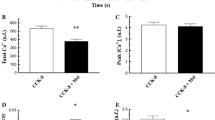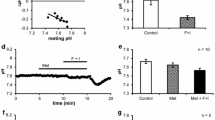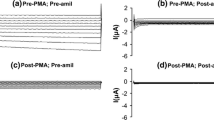Summary
To investigate the mechanism of inositol trisphosphate (IP3)-induced Ca2+ release from the internal Ca2+ store, we examined the effects of heparin, phorbol ester and cyclic nucleotides on Ca2+ release induced by carbachol or inositol 1,4,5-trisphosphate (1,4,5-IP3). For monitoring changes of Ca2+ we used the fluorescent indicator, fura-2, in electropermeabilized rat pancreatic acini. An amount of 100 μg/ml heparin inhibited the Ca2+ release induced by 1 μM 1,4,5-IP3 in permeabilized acini. Pretreatment with 12-O-tetradecanoyl-phorbol-13-acetate (TPA) for 10 min reduced the release of Ca2+ induced by 10 μM carbachol and 1 μM 1,4,5-IP3 in permeabilized acini. Staurosporine, a protein kinase C inhibitor, blocked the inhibitory effect of TPA. Cytosolic calcium concentration was restored by staurosporine in TPA-treated acini. Although cyclic AMP exaggerated the amylase release induced by carbachol, cyclic AMP and cyclic GMP had no effect on the carbachol-induced release of Ca2+ in permeabilized acini. These findings suggest that protein kinase C may act at the level of the IP3 receptors or the IP3-operated Ca2+ channels of the internal Ca2+ store and indicate that cyclic nucleotides do not affect the IP3-induced release of Ca2+ in rat pancreatic acini.
Similar content being viewed by others
References
Amsterdam A, Jamieson JD (1974) Studies on dispersed pancreatic exocrine cells. I. Dissociation technique and morphologic characteristics of separated cells. J Cell Biol 63: 1037–1056
Ansah TA, Dho S, Case RM (1986) Calcium concentration and amylase secretion in guinea pig pancreatic acini: interaction between carbachol, cholecystokinin octapeptide and the phorbol ester, 12-O-tetradecanoylphorbol 13-acetate. Biochim Biophys Acta 889: 326–333
Arita Y, Kimura T, Ogami Y, Nawata H (1991) Effects of H7 and staurosporine on cytosolic free calcium and amylase secretion in rat pancreatic secretion. Pancreas 6:112–119
Ashendal CL (1985) The phorbol ester receptor: a phospholipid-regulated protein kinase. Biochim Biochem Acta 822:219–242
Blanchard LM, Paquette B, Larose L, Morisset J (1990) Carbamylcholine and phorbol esters desensitize muscarinic receptors by different mechanisms in rat pancreatic acini. Pancreas 5:50–59
Bruzzone R, Pozzan T, Wolheim CB (1986) Caerulein and carbamylcholine stimulate pancreatic amylase release at resting cytosolic free Ca2+. Biochem J 235:139–143
Ceska M, Briath K, Brown BA (1969) A new rapid method for the clinical determination of α-amylase activities in human serum and urine. Optimal condition. Clin Chim Acta 26:437–444
De Pont JJHHM, Fleuren-Jakobs AMM (1984) Synergistic effect of A23187 and a phorbol ester on amylase secretion from rabbit pancreatic acini. FEBS Lett 170:64–68
Grynkiewicz G, Poenie M, Tsien RY (1985) A new generation of Ca2+ indicators with greatly improved fluorescence properties. J Biol Chem 260:3440–3450
Heisler S, Kopelman H, Chabot JG, Morel G (1987) Atrial natriuretic factor and exocrine pancreas: effects on the secretory process. Pancreas 2:243–251
Hill TD, Dean NM, Boynton (1988) Inositol 1,3,4,5-tetrakisphosphate induces Ca2+ sequestration in rat liver cells. Science 242:1176–1178
Hootman SR, Valles SM, Kovalcik SA (1991) Mechanism of agonist-induced downregulation of muscarinic receptors in rat pancreatic acini. Am J Physiol 261:G128–135
Kitagawa M, Williams JA, de Lisle RC (1990) Amylase release from streptolysin O-permeabilized pancreatic acini. Am J Physiol 259:G157–164
Knight DE, Baker PF (1982) Calcium-dependence of catecholamine release from bovine adrenal medullary cells after exposure to intense electric fields. J Membr Biol 68:107–140
Krims PE, Pandol SJ (1988) Free cytosolic calcium and secretagogue-stimulated initial pancreatic exocrine secretion. Pancreas 3:383–390
Maruyama Y (1989) Activation and desensitization mechanisms of muscarinic current response in single acinar cells of rats. J Physiol (Lond) 417:343–359
Menozzi D, Sato S, Jensen RT, Gardner JD (1989) Cyclic GMP does not inhibit protein kinase C-mediated enzyme secretion in rat pancreatic acini. J Biol Chem 264:995–999
Nilsson T, Zwiller J, Boynton AL, Berggren PO (1988) Heparin inhibits IP3-induced Ca2+ release in permeabilized pancreatic β-cells. FEBS Lett 229:211–214
Trimble ER, Bruzzone R, Biden TJ, Farese RV (1986) Secretin induces rapid increase in inositol trisphosphate, cytosolic Ca2+ and diacylglycerol as well as cyclic AMP in rat pancreatic acini. Biochem J 239:257–261
Tsunoda Y, Stunkel EL, Williams JA (1990) Oscillatory mode of calcium signaling in rat pancreatic acinar cells. Am J Physiol 258:C147–155
van Heeswijk MPE, Geersten JAM, van Os CH (1984) Kinetic properties of the ATP-dependent Ca2+ pump and the Na+/Ca2+ exchange system in basolateral membranes from rat kidney cortex. J Membr Biol 79:19–31
Varney MA, Rivera J, Lopez Bernal A, Watson SP (1990) Are there subtypes of the inositol 1,4,5-trisphosphate receptor?. Biochem J 269:211–216
Wakasugi H, Kimura T, Haase W, Kribben A, Kaufmann R, Schulz I (1982) Calcium uptake into acini from rat pancreas: evidence for intracellular ATP-dependent calcium sequestration. J Membr Biol 65:205–220
Willems PHGM, van Nooij IGP, Haenen HEMG, de Pont JJHHM (1987) Phorbol ester inhibits cholecystokinin octapeptide-induced amylase secretion and calcium mobilization, but is without effect on secretagogue-induced hydrolysis of phosphatidylinositol 4,5-bisphosphate in rabbit pancreatic acini. Biochim Biophys Acta 930:230–236
Willems PHGM, van den Broek BAM, van Os CH, de Pont JJHHM (1989) Inhibition of inositol 1,4,5-trisphosphate-induced Ca2+ release in permeabilized pancreatic acinar cells by hormonal and phorbol ester pretreatment. J Biol Chem 264:9762–9767
Author information
Authors and Affiliations
Rights and permissions
About this article
Cite this article
Arita, Y., Kimura, T., Ogami, Y. et al. Phorbol ester attenuates inositol 1,4,5-trisphosphate-induced Ca2+ release in electropermeabilized rat pancreatic acini. Res. Exp. Med. 192, 295–303 (1992). https://doi.org/10.1007/BF02576286
Received:
Accepted:
Issue Date:
DOI: https://doi.org/10.1007/BF02576286




